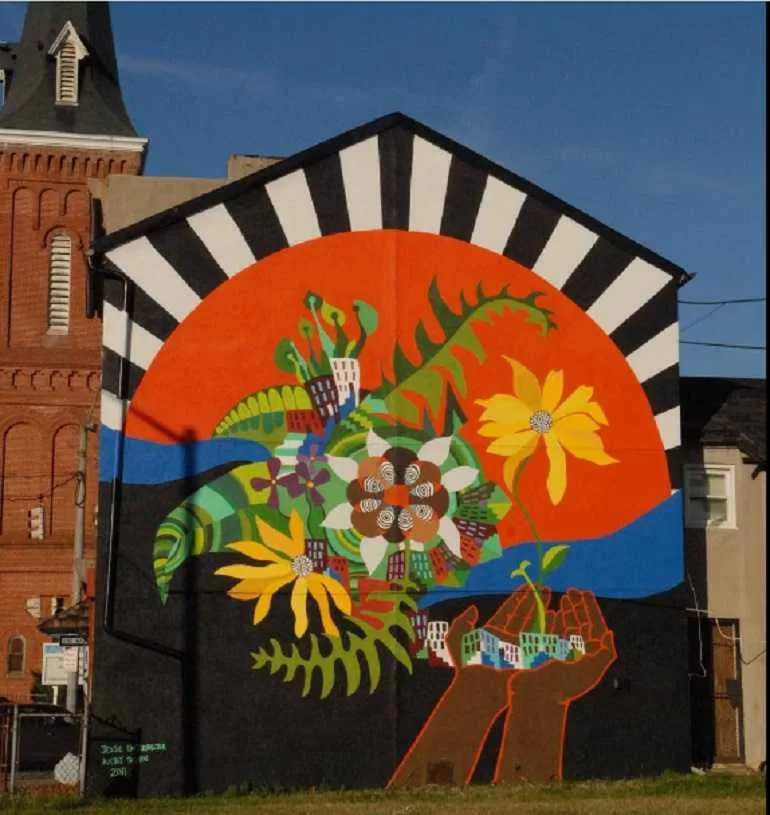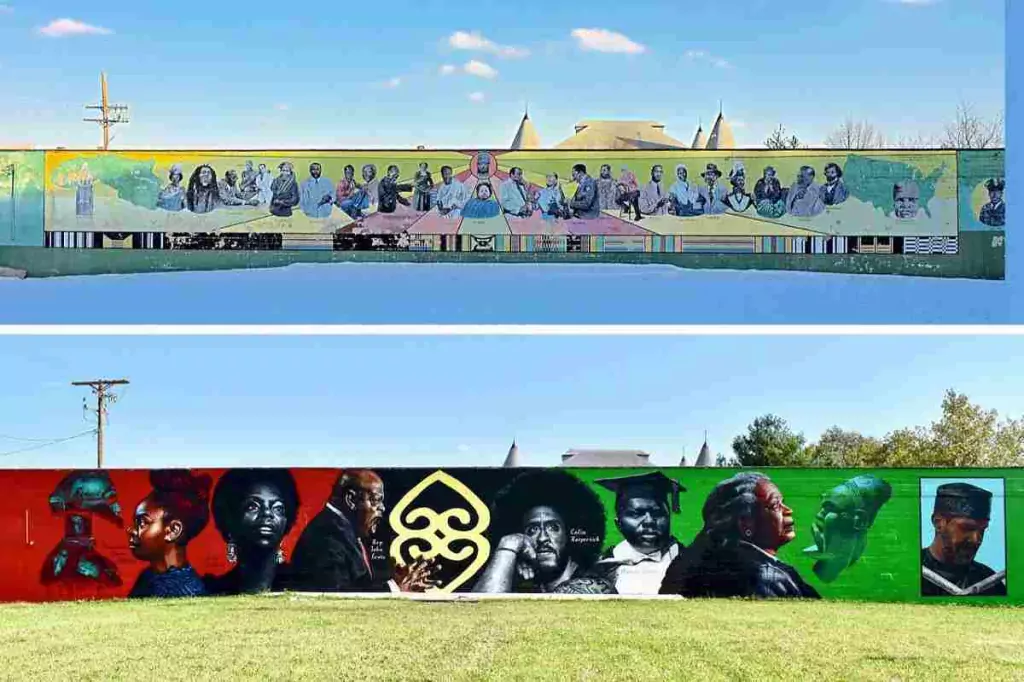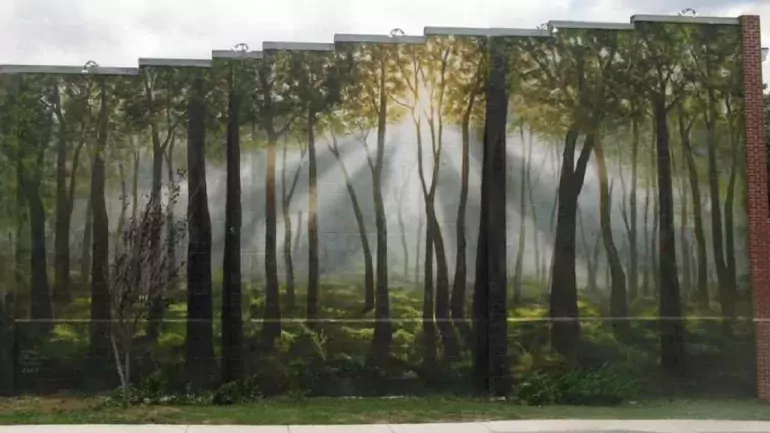ARTCENTRON CELEBRATED
This landscape mural of trees by Lyle Kissack is one of the projects of the Baltimore Mural Program.
Artcentron celebrates the Baltimore Mural Program. Discover how the Baltimore Mural Program transforms neighborhoods with stunning street art while providing opportunities for local artists to showcase their talents and strengths.
BY KAZEEM ADELEKE, ARTCENTRON
BALTIMORE, MARYLAND— On August 25, the Baltimore Mural Program proudly unveiled Bauhaus Blue, a mural reminiscent of the iconic Bauhaus style. It is the creation of Baltimore muralist Jaz Erenberg. Gracefully adorning the side of the building at 1733 Maryland Ave., the artwork not only pays homage to the Bauhaus movement but also takes on the role of a catalyst, infusing new life into Baltimore’s Station North Community.
The unveiling of Bauhaus Blue came just after the completion of yet another exquisite mural embellishing the walls of The Gallery at the Inner Harbor. This stunning mural, Our Baltimore, encapsulates the vibrant essence of a city teeming with vitality. The wraparound mural is the work of two local artists, Eric Abrecht and Andy Snair, who worked in consultation with Turning Art.
Together, these murals stand as testaments to the innovation, dedication, and unwavering commitment of the Baltimore Mural Program in its mission to enhance the beauty of Baltimore.
Baltimore, Maryland: Vibrant Arts Scene

Baltimore, Maryland, has a vibrant arts scene, a rich history, and diverse neighborhoods. One of Baltimore’s most beloved cultural institutions is the Baltimore Mural Program. It was created in 1975 to make Baltimore neighborhoods more attractive. Its objectives were also to instill a sense of pride, provide employment for local artists in their own field, combat graffiti in neighborhoods, and engage young people in the beautification of their own communities. Working with artists, neighborhood groups, associations, and funding sources, the Baltimore Office of Promotion & The Arts (BOPA) coordinates and directs this ongoing program.
What is the Baltimore Mural Program?
The Baltimore Mural Program is a public art initiative that works to beautify Baltimore’s neighborhoods by commissioning large-scale murals and public artworks. The program was a proactive response to the growing problem of graffiti in the city, which was seen as a blight on Baltimore’s urban landscape. By commissioning artists to create high-quality murals in public spaces, the Baltimore Mural Program sought to combat graffiti and other forms of vandalism while also making Baltimore a more beautiful and welcoming place to live and visit.
How Does the Baltimore Mural Program Work?
BOPA, a standalone 501(c)(3) nonprofit organization, serves as the arts council, events producer, and film office for the City of Baltimore. It stands as the foremost advocate for the arts in the vibrant city of Baltimore, and its remarkable annual economic impact on special events and festivals amounts to more than $111.1 million.
Working in collaboration with local neighborhood groups and associations, BOPA identifies sites throughout the city where murals can have the most impact. It then commissions artists to create designs for these sites. Once the designs are approved, the artists are given the resources and support they need to complete their murals. This support includes everything from funding and materials to technical assistance and guidance from experienced muralists.
What Makes the Baltimore Mural Program Unique?
One of the things that sets the Baltimore Mural Program apart from other public art initiatives is its emphasis on community engagement and empowerment. The program works closely with local neighborhood groups and associations to identify sites for murals and involve residents in designing and creating the artwork. By involving local residents in the process, the Baltimore Mural Program is able to create artwork that truly reflects the character and identity of each neighborhood while also empowering residents to take an active role in the beautification of their own communities.
Vibrant Landscape of Baltimore Street Murals

In the vibrant landscape of Baltimore street murals, Wall of Pride (Back to the Future) stands out as a captivating masterpiece, skillfully recreated by Ernest Shaw with the assistance of GAIA, Mural Masters, Deborah Mason, and Michelle Santos. This awe-inspiring mural at 1601 N. Carey St. in Sandtown-Winchester showcases a remarkable array of public figures. Adorning the wall is a captivating array of portraits featuring esteemed individuals such as Colin Kaepernick, Chimamanda Ngozi Adichie, Toni Morrison, Nina Simone, John Lewis, and Marcus Garvey. This striking mural, originally crafted between 1976 and 1977 by Pontella Mason and Avon Martin, is a heartfelt dedication to former President Jimmy Carter. The mural’s current rendition serves an even deeper purpose.
One Day at a Time by Michael Owen
Another remarkable mural, One Day at a Time by Michael Owen, adorns the streets of Maryland Ave. and W. 26th St. in Charles Village. This artwork is truly unique. The artist uses neutral colors and skillful shadows to deliver a powerful message to passersby. Its purpose is to raise awareness about addiction and the journey to recovery, with an impact that extends far beyond its visual beauty.
The Freddie Gray mural is truly moving, serving as a poignant tribute to the young Baltimorean who tragically lost his life while in police custody. It eloquently captures the essence of the civil rights struggle by placing Gray alongside Dr. Martin Luther King, Jr., and other marchers from that historic movement. Additionally, it skillfully juxtaposes images of contemporary protesters fighting against injustice.
Renowned muralist Nether, known for his impactful works around West Baltimore, collaborated closely with Gray’s family on this project. The mural conveys the unity and strength of purpose shared by activists from both eras, forging a powerful force against inequality. As a testament to the enduring spirit of change and justice in the city’s heart, this mural holds a special place in the hearts of those who encounter it.
Impact of the Baltimore Mural Program on Baltimore

Since its creation in 1975, the Baltimore Mural Program has had a significant impact on the city of Baltimore. By commissioning large-scale murals and public artworks, the program has helped to beautify the city’s neighborhoods, combat graffiti and other forms of vandalism, and create opportunities for local artists to showcase their work and build their careers.
In addition to these tangible benefits, the Baltimore Mural Program has also had a profound impact on the social fabric of the city. By engaging local residents in the creation of these artworks, the program has helped to build community pride and strengthen social bonds. The program has also provided a platform for underrepresented artists and communities to have their voices heard, helping to promote diversity and inclusivity in Baltimore’s arts scene.
Artists and Community Selections
Murals can add color, vibrancy, and character to a building or public space. They can also be a great way to engage the community and promote local culture. As a Baltimore artist or community member, bringing a mural to your neighborhood requires some effort.
The process of selecting artists for Baltimore’s murals is a collaborative effort, often involving community input and artistic expertise. Neighborhoods interested in requesting murals typically initiate the process by engaging with local art organizations or the BOPA. After discussing their vision and needs, a call for artists may be issued, inviting both local and external talent to submit proposals. A panel of experts, which can include community members, artists, and representatives from BOPA, reviews the proposal. The selected artist or team collaborates closely with the community throughout the creative process, ensuring that the mural reflects the neighborhood’s unique identity and aspirations. This democratic and artistic approach fosters a sense of ownership and pride among residents.
Approval Process for a Mural in Baltimore: An Overview
Although the process of getting approval for a mural can seem daunting at first, it is easy to accomplish. Below is an outline of the mural approval process in Baltimore, as well as factors that can affect mural costs. Getting approval for a mural in Baltimore is not a difficult process, but it does involve several steps and considerations. By working with a community or neighborhood association and following the guidelines set forth by the city, artists and community members can bring beautiful and meaningful murals to their neighborhoods.
The process for getting approval for a mural in Baltimore typically involves the following steps:
- Mural Design and Productions
The first step in getting approval for a mural is to design and produce the artwork itself. In most cases, a muralist will work in collaboration with a community or neighborhood association to develop a concept that reflects the local culture and values. The mural artist will typically work under a contract with the community association or the building owner, which outlines the scope of work, timeline, and compensation.
- Right of Entry Approval
Once the mural design is complete, the building owner must provide written acceptance of the mural, known as a “Right of Entry.” This document outlines the terms of the agreement between the building owner and the mural artist. It also gives the artist permission to access the property and install the mural. If the property belongs to the city, a “Right of Entry” will come from Baltimore Housing’s Office of Legal Affairs.
- CHAP Review (if applicable)
If the building is in a historic district, the mural and its design must be reviewed by the Baltimore City Commission for Historical and Architectural Preservation (CHAP). This review ensures that the mural is appropriate for the historic district and meets certain standards for quality and aesthetics.
- Installation and Maintenance
Once all necessary approvals have been obtained, the mural can be installed. The artist will typically provide their own supplies and equipment and may need to rent specialized equipment such as scaffolding or lifts. After installation, the mural may require ongoing maintenance to keep it looking its best.
Factors that Affect Mural Costs
The price of commissioning a mural can fluctuate significantly, influenced by a myriad of factors, such as:
- The wall size and Condition
The size and condition of the wall that the mural will be on can have a significant impact on costs. A larger wall will require more paint and materials, while a wall in poor condition may require additional preparation and repair work before the mural can be installed.
- Artist’s Fee
The artist’s fee is another major factor in the cost of a mural. Experienced and highly skilled artists may command higher fees, while less experienced artists may charge less.
- Cost of sundries and supplies
In addition to the cost of the artist’s fee, there are also costs associated with supplies and accessories such as paint, brushes, and other materials.
- Equipment Rentals
If specialized equipment, such as scaffolding or lifts, is needed to install the mural, this can also add to the overall cost.
Resources on Baltimore Murals and the Mural Program
For readers eager to delve deeper into the world of Baltimore murals and the Baltimore Mural Program, there’s a wealth of additional resources available. You can explore specific murals, their stories, and the talented artists behind them through online sources like the Baltimore Office of Promotion and the Arts website, where you’ll find comprehensive information and images. There is also the opportunity to connect with local art organizations and visit dedicated mural tours in Baltimore to get up close and personal with these remarkable expressions of creativity and community. The Baltimore City Mural Map is an important source to help navigate the locations of important Baltimore murals. Other resources include the Station North Art District and the Baltimore Mural Program.
Artcentron Celebrates the Baltimore Mural Program
Artcentron celebrates the Baltimore Mural Program because of its impact across Baltimore. Although a major objective of this public art initiative was to combat graffiti and vandalism, it has made Baltimore’s neighborhoods more attractive and instilled a sense of pride in local communities. With the support of the Baltimore Office of Promotion & The Arts, the program is unique in its emphasis on community engagement and empowerment, which involves local residents in the design and creation of murals to reflect each neighborhood’s character and identity. Since its inception, the program has had a significant impact on Baltimore by beautifying its neighborhoods, promoting diversity and inclusivity in the arts scene, and building community pride.
